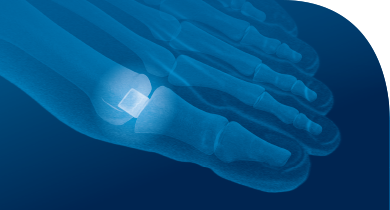What is Hallux Limitus/Hallux Rigidus?
Arthritis is a common cause of pain and stiffness in the big toe. In the early stages, big toe arthritis reduces the range of motion of the big toe joint. This is known as ‘Hallux Limitus’. As the condition progresses, it can cause the joint to become completely rigid and it is no longer possible to bend the toe. At this point, it is known as ‘Hallux Rigidus’.
Symptoms
Pain is present at the base of the big toe, especially when walking. It may be associated with swelling around the joint, a painful bony bump on the top of the big toe joint, as well as stiffness and inability to bend the toe.
Diagnosis
Dr Buckley will perform a physical examination and will order xrays to determine if any bone changes and loss of joint space has occurred.
Surgical Treatment
There are several techniques that Dr Buckley performs for hallux limitus and hallux rigidus (big toe arthritis). The objective of the surgery when the condition is in its early stages is to improve and maintain big toe joint mobility, alleviate pain and promote ongoing joint health.
1. Cheilectomy
For mild big toe arthritis, the most common procedure is known as a Cheilectomy. This involves shaving off bony spurs around the surface of the big toe joint and using specialised drills to repair damaged cartilage. Where appropriate, Dr Buckley will combine this with a realignment procedure of the bone at the base of the big toe (Moberg osteotomy). This combination can provide long lasting pain relief and improved movement of the big toe in the appropriate patient.
2. Implant Arthroplasty (joint replacement)
For moderate cases of Hallux Rigidus, Dr Buckley offers a joint replacement procedure using Cartiva Synthetic Cartilage Implants. The Cartiva SCI is the first implant that behaves like the natural cartilage of your joint to relieve pain and improve mobility. Joint replacement preserves more joint movement than traditional fusion surgery (arthrodesis), allowing patients to continue to wear heeled shoes.
joint to relieve pain and improve mobility. Joint replacement preserves more joint movement than traditional fusion surgery (arthrodesis), allowing patients to continue to wear heeled shoes.
3. Arthrodesis (joint fusion)
Occasionally where the condition of the joint has deteriorated significantly and is beyond repair, a joint fusion procedure may be recommended. This involves removing the remaining cartilage in the joint and then fusing together the bones on either side of the joint using screws or a plate. This procedure has shown to be highly successful in providing permanent pain relief.
Recovery
Patients are able to bear weight immediately post-surgery and usually return to normal activities within a month after the surgery. Following the procedure, Dr. Buckley prefers to review his patients several times to ensure that their recovery is proceeding satisfactorily.
Hallux limitus surgery indications
- Pain in the big toe joint
- Problems fitting into shoes
- Discomfort when performing daily activities.
- Painful plantar callus beneath the big toe/big toe joint
- Conservative care, such as orthotics or different shoes, has proven ineffective
Hallux limitus surgery aims
- Reduce pain and deformity
- Improve big toe mobility and alignment
- Prevent callus formation
To book a consultation with Dr Ned Buckley regarding Hallux Limitus Surgery, please contact our clinic on 9481 8194 or use our online booking system for an instant appointment.
Any surgical or invasive procedure carries risks. Before proceeding, you should seek a second opinion from an appropriately qualified health practitioner.
